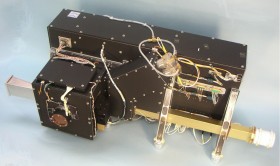
|
COSIMA
|
 |

|
COSIMA
|
 |
 COSIMA is the in-situ dust analysing system on the orbiter of ESA's Rosetta mission to comet 67P/Churyumov-Gerasimenko and will perform measurements on individual dust particles emitted by the comet and collected by COSIMA dust collector.
COSIMA is the in-situ dust analysing system on the orbiter of ESA's Rosetta mission to comet 67P/Churyumov-Gerasimenko and will perform measurements on individual dust particles emitted by the comet and collected by COSIMA dust collector.
The COSIMA instrument is a secondary ion mass spectrometer equipped with a dust collector, an ion gun, and an optical microscope for target characterization. Dust from the near comet environment is collected on a target. The target is moved to a microscope imager and the positions of the collected grains are determined. The cometary grains are bombarded with a liquid indium ion gun. The resulting secondary ions are extracted into a time-of-flight mass spectrometer and the secondary mass spectra are recorded for science analysis.
| Science Objectives |
|
| The Instrument |
|
| Operations |
|
| The Team |
|
| COSIMA publications by MPS members |
The main objective of COSIMA is to study the physical and chemical compositions and processes that occur in, on, and near the cometary nucleus. In particular, COSIMA allows researchers to determine the composition of dust particles from different regions of the cometary nucleus and released at different activity periods, and to compare dust grain mineralogy, chemistry and composition. The main science objectives of COSIMA are:
 The COSIMA instrument is a time-of-flight secondary ion mass spectrometer equipped with a dust collector, a primary ion gun, and an optical microscope (COSISCOPE) for target characterization. Once one of the targets has been exposed to cometary dust it is transferred to the focal plane of the microscope and imaged under shallow angle illumination provided by light emitting diodes. On-board image evaluation detects the presence and location of dust particles with diameters exceeding a few µm and calculates their position relative to the target reference point. Once the presence of features of interest is established, the target is moved in front of the mass spectrometer. Three nanosecond duration pulses of indium-115 with an energy of 8 keV and about 50 µm in diameter from the primary ion gun impact on the selected feature. Secondary ions from the cometary grains are extracted by an extraction lens into the TOF section.
The COSIMA instrument is a time-of-flight secondary ion mass spectrometer equipped with a dust collector, a primary ion gun, and an optical microscope (COSISCOPE) for target characterization. Once one of the targets has been exposed to cometary dust it is transferred to the focal plane of the microscope and imaged under shallow angle illumination provided by light emitting diodes. On-board image evaluation detects the presence and location of dust particles with diameters exceeding a few µm and calculates their position relative to the target reference point. Once the presence of features of interest is established, the target is moved in front of the mass spectrometer. Three nanosecond duration pulses of indium-115 with an energy of 8 keV and about 50 µm in diameter from the primary ion gun impact on the selected feature. Secondary ions from the cometary grains are extracted by an extraction lens into the TOF section.
After passing deflection plates for beam steering, the ions travel through a field free section. Next they pass a two stage reflector and return through the drift section to the single stage microsphere plate ion detector. The arrival time of each ion is measured with an accuracy of about 2 ns. Precision in the timing of the primary ion pulses, the correct selection of the dimensions and the voltages of the mass spectrometer and the accurate measurement of the secondary ion flight time are mandatory perquisites to obtain the high mass resolution in the COSIMA instrument (about 1500 at 100 amu).
Since March 2005 instrument health has been monitored in a checkout every 6 months. The instrument proved to be in good health during the checkouts performed so far. Operations have included mechanism tests, instrument calibration, ion source maintenance, and interference check between COSIMA and other instruments. After the launch of Rosetta (2nd March 2004), COSIMA was commissioned in three slots between March 2004 and October 2004, and has been and will be active on several occasions before Rosetta arrives in 2014 at its main target, comet 67P/Churyumov-Gerasimenko.
The COSIMA instrument was designed and provided by the COSIMA team, a consortium from multiple European countries, scientific institutes and industry, under the leadership of the Max-Planck-Institute for Extraterrestrial Physics, Garching, Germany (Principal Investigator: Jochen Kissel).
COSIMA is operated by the COSIMA team under the guidance of the Max-Planck-Institute for Solar System Research, Katlenburg-Lindau, Germany (Principal Investigator: Martin Hilchenbach).
The Cosima Instrument Operation Team |
|||
| MPS | |||
|---|---|---|---|
| Martin Hilchenbach | Principal Investigator | +49 5556 979 162 | |
| Jochen Kissel | Principal Investigator (up to May 2005 - retired) | ||
| Harald Krüger | Co-Investigator, COSIMA Science Calibration | ||
| Henning Fischer | System engineer, flight and ground reference instrument | ||
| FMI | |||
| Jouni Rynö | Co-Investigator, COSIMA Flight Operations | ||
| Maria Genzer | COSIMA documentation management | ||
| © 2006, Max Planck Institute for Solar System Research, Lindau |
M. Hilchenbach 26-02-2009 |